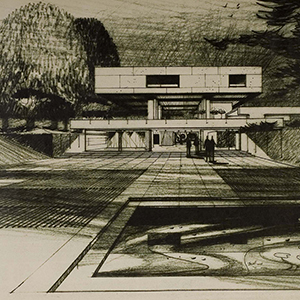Persistence and change
Amancio Williams and the architectural production modes after the post Second World War period
DOI:
https://doi.org/10.35305/23626097v6i11.226Keywords:
Amancio Williams, Walter Gropius, architectural project, professional fieldAbstract
Important changes took place in the organization and the way of managing the work in architects’ offices after the post Second World War period. While the tradition of the atelier focused on the figure of only one prestigious architect remained, a modality brought about by the corporate business environment began to emerge. The latter led companies to appeal to not only the constitution of work teams but also the involvement of other disciplines. In Argentina, the best example of the traditional case would be represented by Amancio Williams. The episode that linked him to Walter Gropius in order to carry out a joint project in the late 1960s, shows the way in which the professional field had been modified as well as the strong transformation signs that had already appeared in Argentina.
Downloads
Metrics
References
Bill, M. (1966). The work of Amancio Williams. Zodiac, (16), 36-73.
Gropius, I. (1968, julio 8). [Telegrama a Amancio Williams]. Archivo Amancio Williams.
Gropius, W. (1969, febrero 19). [Carta a Amancio Williams]. Archivo Amancio Williams.
Gropius, W. (1969, mayo 13). [Carta a Amancio Williams]. Archivo Amancio Williams.
Hitchcock, H.-R. (1947). The architecture of bureaucracy and the architecture of genius. Architectural review, 101(601), 3-6.
Kubo, M. (2014). The concept of the architectural corporation. En E. Franch et al. (Eds.), Office US Atlas (Repository) (pp. 37-45). Zurich, Suiza: Lars Müller Publishers.
Liernur, J. F. (2004). Vanguardistas Vs. Expertos. Block, (9), 18-39.
Merro Johnston, D. (2011). El autor y el intérprete. Le Corbusier y Amancio Williams en la Casa Curutchet. Buenos Aires, Argentina: 1:100.
Merro Johnston, D. (2014). La casa sobre el arroyo. Amancio Williams en Argentina. Buenos Aires, Argentina: 1:100.
Müller, L. (2018). Fuego cruzado. Gropius / Williams y el caso de la embajada de Alemania en Buenos Aires. En: L. Müller et al.; A. Monti (Comp.); A. M. Rigotti (Dir.); S. T. Pampinella (Ed. lit.), Profesionales, expertos y vanguardia: la cultura arquitectónica del Cono Sur: Actas Seminario Internacional (pp. 10-16). Rosario, Argentina: UNR Editora. Recuperado de: https://fapyd.unr.edu.ar/publicaciones/
Pando, H. (1996). Pensamiento y obra de Amancio Williams. Cuadernos de historia, (7), 93-135.
Pando, H. (2008). Clase IV. Pautas subjetivas para el diseñador. En J. M. Boggio Videla. (Ed.), Pando, Williams y Casares hablan de diseño (pp. 80-92). Buenos Aires, Argentina: Concentra.
Shmidt, C. y Adagio, N. (2012). Dos horas con Francisco Bullrich a sus 81 años. (Entrevista del 11 de julio de 2011). En N. Adagio (Ed.), Antología. La biblioteca de la arquitectura moderna: Argentina 1929-1963 (pp. 352-361). Rosario, Argentina: A&P.
Silvestri, G. (2007). El primero entre los carpinteros. Notas sobre las relaciones entre técnica y arte desde la mirada del arquitecto. Revista de Arquitectura, (225), 120-131.
Williams A. (1947 abril, 15). [Carta a Atilio Bramuglia, Ministro de Relaciones Exteriores y Culto de la Nación] Archivo Amancio Williams.
Williams A. (1950, febrero 6). [Carta a Vanu Bhuta] Archivo Amancio Williams.
Williams A. (1951, marzo 16). [Carta a Henry Seljak]. Archivo Amancio Williams.
Williams A. (1968, marzo 18). [Carta a Walter Gropius]. Archivo Amancio Williams.
Williams, A. (1949). Arquitectura y urbanismo de nuestro tiempo. Buenos Aires, Argentina: Kraft.

Published
How to Cite
Issue
Section
License
Open access policy
A&P Continuidad is a non-profit and open access publication. According to Mexico Declaration on Cultural Policies, the journal distribution is submitted to Creative Commons Attribution-Noncommercial-ShareAlike 4.0 International Public License (CC BY-NC-SA). “Neither the commercial use of the original work nor that of the possible derivative works are allowed. The distribution of derivative works should be submitted to the license regulating the original work. This license is not free.”
A&P Continuidad authorizes the partial or full reproduction of texts and graphs provided that the source is cited. Authors are exclusively responsible for the criteria expressed in the articles which do not necessarily reflect the opinion of the Editorial Committee or that of the Direction Board. The copyright of the published articles pertains to their authors or publishers.
Transfer of rights
The acceptance of an article to be published implies the author’s transfer of rights to the journal. Authors continue to have the right to use the material in future books or publications, approve or veto the republication of their works as well as the rights related to patents or other rights. Transfer of rights form may be downloaded here.























 This OJS site and its metadata are under a
This OJS site and its metadata are under a 

